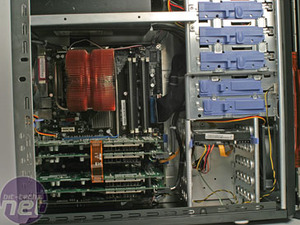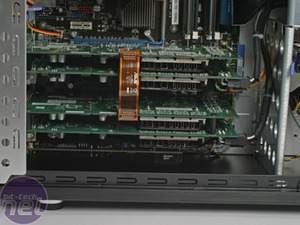Obviously, we used a pair of GeForce 7950 GX2's in our system. The cards that we chose were XFX's 7950 GX2 Extreme, which come clocked at 520/1300MHz - these clocks are slightly higher than NVIDIA's reference 500/1200 reference clocks used by most add-in board partners.
They are priced quite competitively with the reference cards, too. At around £390 including VAT each, they're only £25 more than the cheapest GeForce 7950 GX2 on Scan.
Once everything was installed, we tidied the cables away and configured the BIOS ready for installing Windows XP. At this point, we exchanged the 4x512MB DIMMs for a pair of 1GB Corsair XMS2-6400C3 modules, so that we were able to turn on the 1T command rate timing.
We were able to get the memory to run completely stable at DDR2-800 with 3.0-3-3-9-12-1T timings with 2.2V vDIMM. At these settings, the modules passed two full loops of Memtest86 without an error. We then installed Windows XP without any problems.


After installing the latest version of the nForce4 SLI X16 Intel Edition drivers (version 6.86 WHQL at the time of writing), we rebooted and were prompted to install the video card drivers.
We used Forceware version 91.37, which are publicly available from SLI Zone. These installed without a hitch, and after reboot, Quad SLI was automatically enabled. This was a little strange, as we're normally used to enabling SLI ourselves - maybe this is a sign of things to come, where the driver automatically detects whether a pair of compatible video cards are installed? We installed Quake 4 and had a quick Deathmatch over the office network to check that the system was functioning correctly in a gaming environment - we were immediately impressed with how the system performed.


At this point, we decided to crave for more and started overclocking our Core 2 Extreme X6800 processor. We were able to get the CPU running stable at 3.46GHz with 1.500V vCore - temperatures were at 55'C after the machine had been loaded with two instances of Prime95 for 24 hours. We achieved this clock speed by simply increasing the CPU multiplier from 11x to 13x - the front side bus and memory bus were still running at 1066MHz and 800MHz respectively.
They are priced quite competitively with the reference cards, too. At around £390 including VAT each, they're only £25 more than the cheapest GeForce 7950 GX2 on Scan.
Once everything was installed, we tidied the cables away and configured the BIOS ready for installing Windows XP. At this point, we exchanged the 4x512MB DIMMs for a pair of 1GB Corsair XMS2-6400C3 modules, so that we were able to turn on the 1T command rate timing.
We were able to get the memory to run completely stable at DDR2-800 with 3.0-3-3-9-12-1T timings with 2.2V vDIMM. At these settings, the modules passed two full loops of Memtest86 without an error. We then installed Windows XP without any problems.


After installing the latest version of the nForce4 SLI X16 Intel Edition drivers (version 6.86 WHQL at the time of writing), we rebooted and were prompted to install the video card drivers.
We used Forceware version 91.37, which are publicly available from SLI Zone. These installed without a hitch, and after reboot, Quad SLI was automatically enabled. This was a little strange, as we're normally used to enabling SLI ourselves - maybe this is a sign of things to come, where the driver automatically detects whether a pair of compatible video cards are installed? We installed Quake 4 and had a quick Deathmatch over the office network to check that the system was functioning correctly in a gaming environment - we were immediately impressed with how the system performed.


At this point, we decided to crave for more and started overclocking our Core 2 Extreme X6800 processor. We were able to get the CPU running stable at 3.46GHz with 1.500V vCore - temperatures were at 55'C after the machine had been loaded with two instances of Prime95 for 24 hours. We achieved this clock speed by simply increasing the CPU multiplier from 11x to 13x - the front side bus and memory bus were still running at 1066MHz and 800MHz respectively.

MSI MPG Velox 100R Chassis Review
October 14 2021 | 15:04









Want to comment? Please log in.